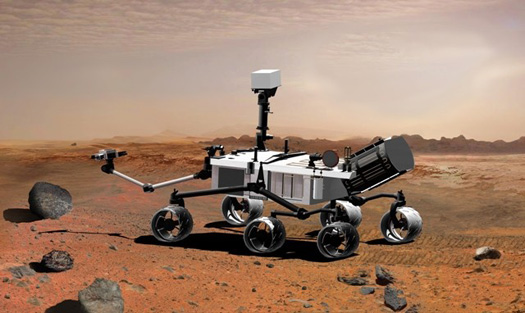

Mission scientists at NASA are narrowing down the shortlist of proposed landing sites for the agency’s next Mars rover, and the two frontrunners that have emerged over the past week (from a shortlist of four) are tantalizing scientific targets indeed. One is a former crater lake that could be rich in sediments harboring a record of Martian geological history. The other is even more ambitious: a crater that is home to a three-mile high rocky mound. That’s nearly as tall as Mount Kilimanjaro.
Both sites could be boons for Mars research. The mound-boasting crater, known as the Gale Crater, contains things that require water to form, like clays and certain sulphates. And because the mound is in a crater, it’s kind of like a trap for sediments. Eberswalde, the other crater, also appears to be full of clays that were dumped there by a river that once flowed into it.
But at this point, it seems that Eberswalde is more of a gamble. If the sediments there turn out to be nothing more than simple rocks, the mission could be largely a failure from a scientific standpoint. Moreover, Eberswalde is further from the Martian equator, and hence colder. That means Curiosity would need additional heating to function there, and that could erode its life expectancy.
Does that make Gale a lock? Not exactly, but it would make for one interesting mission and one unlike any other ever undertaken by rovers on the Red Planet. The processes that created the mound in Gale are also unclear, but researchers are pretty sure that both clays and sulphates are present there, making it the only site among the final four to have both materials potentially present. And let’s not forget, a trip to Gale isn’t just a rover mission. It’s a mountaineering mission.
The idea is for Curiosity to land near the mound, then drive up its surface, sampling and analyzing on its way up. This should show the way the planet’s geology and hydrology changed over time. It could also yield organic material, if indeed there is any there. Mission scientists think Curiosity could cover at least the first thousand feet or so in its design lifetime.
But Opportunity is still functioning a full seven years after its three-month mission expired. Which means if Curiosity is half as hardy, it could climb a mile, or even two, before running out of steam. We’ve got a lot of great pics of the Martian surface as seen from the ground, but image the vistas from atop the Gale mound.
Of course, NASA doesn’t have to select either of these potential sites. The final decision is up to NASA brass and the actual Curiosity mission team. That final decision is expected in July.
